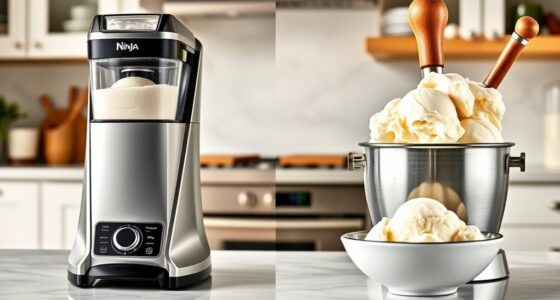If you’re confused by ice cream machine terms like overrun, churning speed, freezing methods, or hardening time, don’t worry—you’re not alone. Overrun affects how airy your ice cream is, while churning speed impacts creaminess and texture. Freezing techniques and temperature settings control how smooth and firm your final product turns out. Understanding each component’s role helps you produce better ice cream. Keep going, and you’ll gain the clarity needed to master your machine and make perfect treats.
Key Takeaways
- Understand overrun as the air whipped into ice cream, affecting fluffiness and flavor intensity.
- Learn how mixing cycles influence creaminess, texture, and flavor distribution during churning.
- Know that churning speed and duration impact smoothness, air incorporation, and ice crystal formation.
- Recognize the importance of proper freezing techniques and hardening time for ideal texture and mouthfeel.
- Familiarize with equipment components like freezing cylinders and agitators that ensure consistent, quality ice cream production.
Understanding Overrun: What It Means for Your Ice Cream
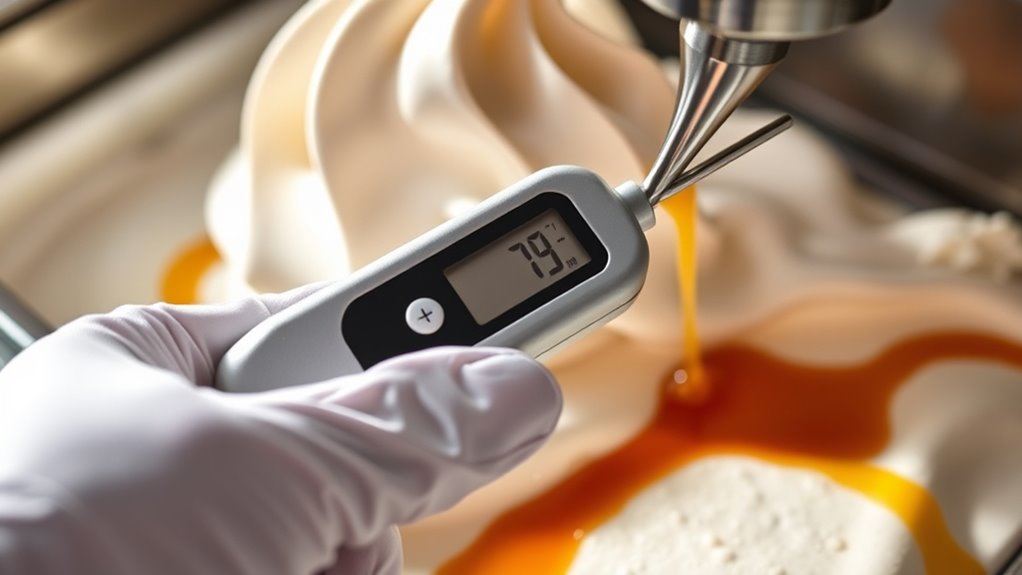
Have you ever wondered why some ice creams feel lighter and fluffier than others? That’s often due to overrun—the amount of air whipped into the mixture during churning. Overrun affects texture, making ice cream seem more airy and less dense. When the machine creates a good flavor infusion, it also disperses ingredients evenly, ensuring each bite has consistent flavor and texture. A higher overrun means more air, which enhances the lightness but can dilute flavors if overdone. Conversely, low overrun results in denser ice cream with richer taste. Understanding this balance helps you control your ice cream’s texture and flavor profile. Proper ingredient dispersion and overrun management guarantee your ice cream is perfectly fluffy and flavorful every time.
Hardening Time: Why It Matters and How to Optimize It
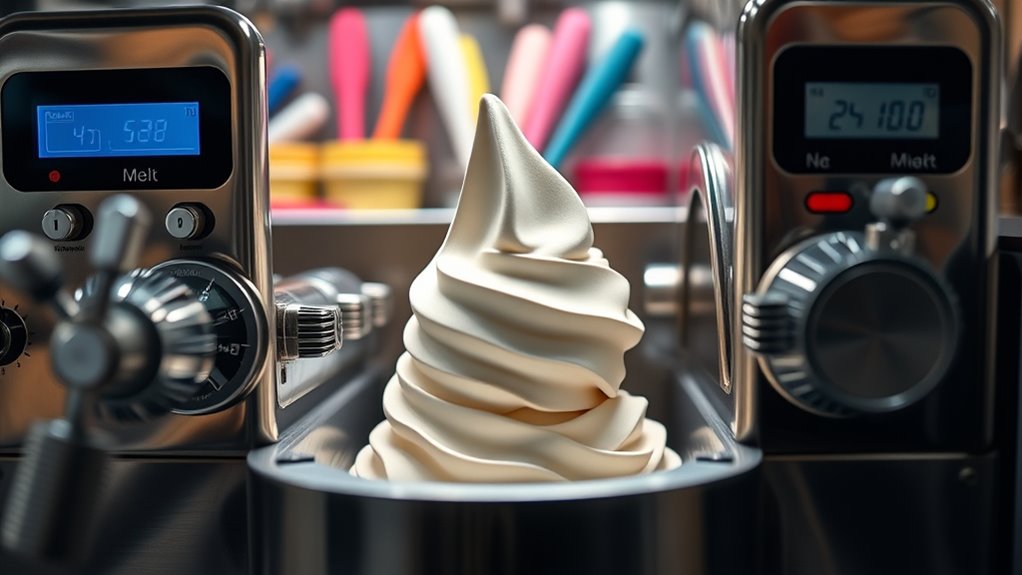
After achieving the right overrun and evenly dispersing ingredients, the next step to perfect ice cream texture is proper hardening. Hardening time is vital because it guarantees the ice cream reaches the ideal consistency for serving. Proper hardening enhances texture by reducing ice crystal size, resulting in smoother, creamier ice cream. It also helps lock in flavors, allowing for better flavor infusion and overall taste. If you rush this step, your ice cream may become icy or too soft, compromising quality. To optimize hardening, monitor temperature carefully—typically around -20°F (-29°C)—and avoid opening the freezer frequently. Proper hardening not only improves texture but also preserves flavor integrity, giving you that perfect scoop every time. Additionally, using a head thermometer can help ensure your freezer stays within the optimal hardening temperature for ideal hardening conditions.
Mixing Cycles and Their Role in Ice Cream Texture
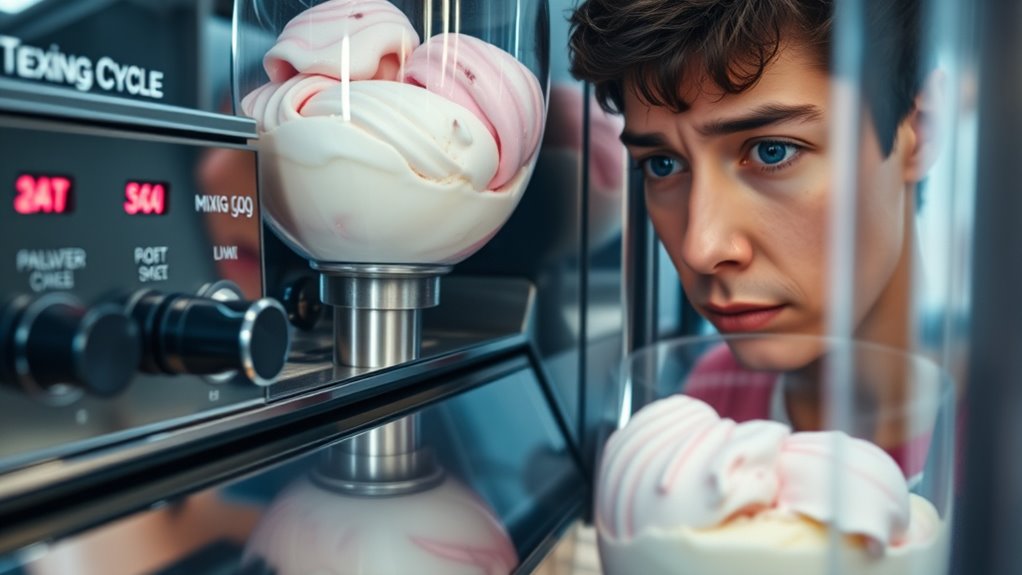
Mixing cycles directly influence the cream’s consistency, shaping how smooth or icy your ice cream turns out. By adjusting these cycles, you can better control the texture and density, ensuring it’s just right. Understanding how mixing impacts these factors helps you create a perfect treat every time. Additionally, being aware of AI vulnerabilities can inform better safety practices in automated kitchen appliances. Proper calibration of the projector settings can further enhance your ice cream’s texture by ensuring even mixing and freezing. Maintaining optimal machine maintenance is also essential to achieve consistent results and prevent potential malfunctions. For example, Kia Tuning techniques such as ECU remapping and suspension upgrades demonstrate how precise adjustments can optimize performance and reliability. Regularly inspecting and replacing filtration components ensures the pump and spray system remain free of debris, which is analogous to maintaining consistent mixing cycles in your ice cream maker.
Impact on Cream Consistency
Ever wondered how the number and timing of mixing cycles influence the cream’s texture? These cycles directly impact flavor infusion and ingredient emulsification, which are essential for a smooth, consistent ice cream. More frequent mixing can enhance flavor distribution evenly throughout the mixture, ensuring every spoonful tastes balanced. Additionally, proper mixing promotes ingredient emulsification, breaking down fats and stabilizers to create a uniform, creamy texture. Insufficient cycles may result in a grainy or icy mouthfeel, while excessive mixing could overdevelop the mixture, making it too soft or runny. By carefully controlling the timing and frequency of mixing cycles, you can achieve a consistent, velvety ice cream that’s rich in flavor and perfectly smooth in texture.
Controlling Texture and Density
Controlling texture and density in ice cream hinges on the timing and frequency of mixing cycles. Proper cycles guarantee even flavor infusion and manage ingredient variance, impacting creaminess and firmness. Too few cycles lead to dense, icy textures, while too many can make the ice cream overly soft. Adjusting mixing cycles influences how ingredients blend and air is incorporated, which directly affects mouthfeel. Consider these key points:
- Increasing cycles enhances flavor infusion but risks over-softening.
- Fewer cycles create a denser texture with less air.
- Timing cycles during freezing affects ingredient variance, ensuring uniform consistency and optimal texture.
- Balancing cycle frequency helps achieve desired density without sacrificing flavor integrity.
- Properly managing mixing cycles is essential for texture and overall quality of your ice cream, especially since air incorporation plays a significant role in final product quality. Recognizing the importance of process control in ice cream production can help optimize each batch for superior results.
Mastering mixing cycles allows you to fine-tune your ice cream’s texture, ensuring perfect creaminess and balanced flavor infusion every time.
The Significance of Churning Speed and Duration
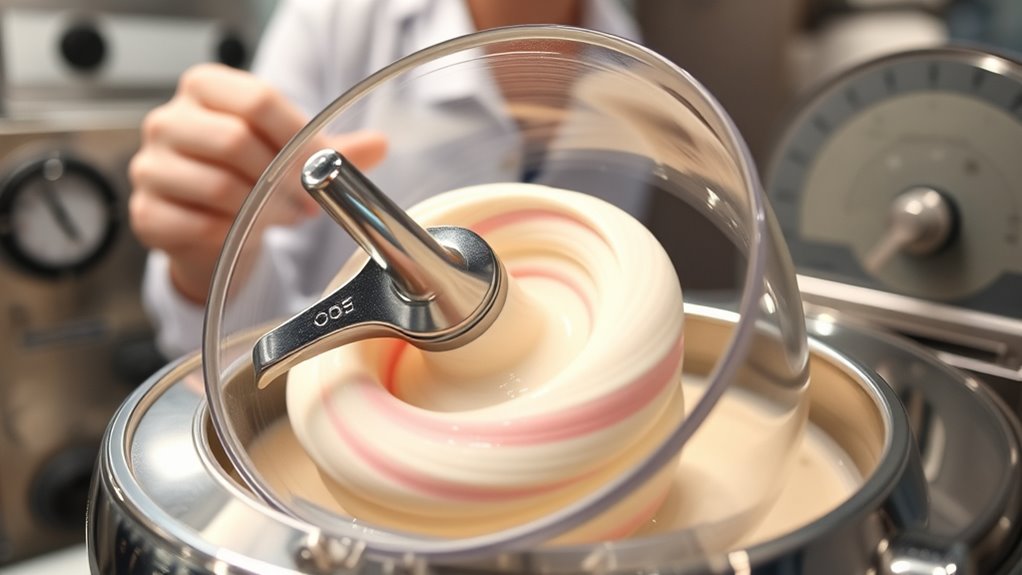
The speed at which an ice cream machine churns and the duration of that process play critical roles in determining the quality of your final product. If the churning speed is too fast, it can lead to over-agitation, resulting in a denser, less creamy texture. Conversely, if it’s too slow, the mixture may not incorporate enough air, making it feel heavy or icy. Proper mix consistency is essential for achieving the desired texture, and adjusting the speed accordingly ensures optimal air incorporation. Maintaining a consistent churning process helps achieve uniform results. The engine tuning techniques used in Volkswagen models demonstrate how precise adjustments can improve performance and efficiency, similar to optimizing churning parameters for ice cream. Additionally, understanding the tuning speed specific to your machine can help prevent common issues like freezer burn or inconsistent texture. Duration control is equally important; churn too long, and the ice cream can become icy or hard, while too short a time may leave it soft and runny. Finding the right balance ensures your ice cream is smooth, fluffy, and perfect. Paying attention to these factors helps you produce consistently high-quality ice cream tailored to your preferences. Using appropriate equipment settings and understanding their impact can further refine your results.
Different Types of Freezing Methods Explained
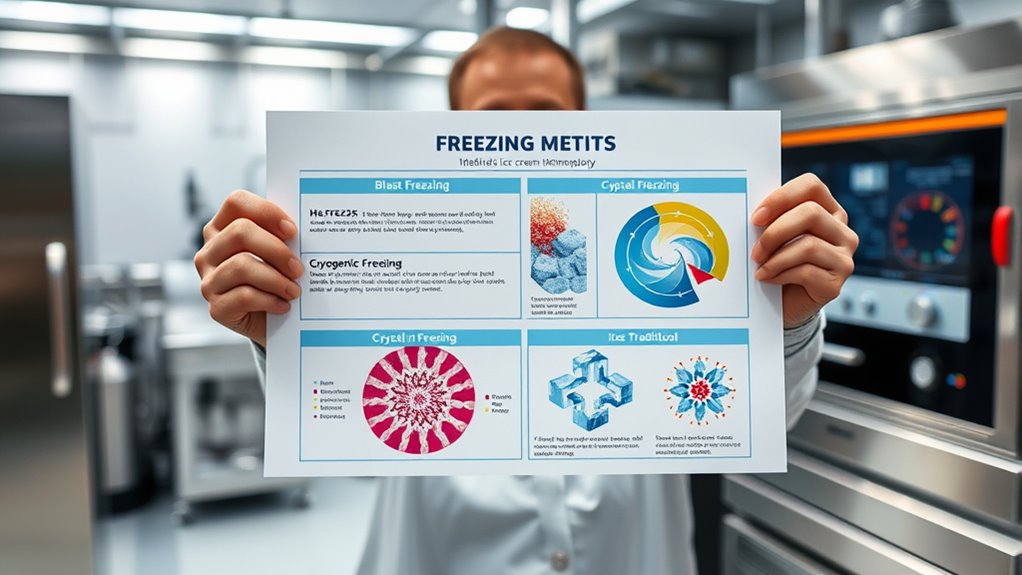
Choosing the right freezing method can considerably impact the texture and consistency of your ice cream. Different freezing techniques and machine configurations determine how smoothly or chunky your final product turns out. Here are four common methods:
- Batch Freezing: Uses a continuous churning process in specialized machines, ideal for small-scale production. This method often involves controlled agitation to ensure even freezing and prevent ice crystal growth. Proper temperature control is essential during this process to achieve the desired creaminess and avoid large ice crystals. Additionally, the type of freezing equipment used can influence the uniformity of the final product. Selecting the appropriate freezing technique is crucial for achieving optimal ice cream texture.
- Hardening Freezing: Rapidly lowers temperature, creating dense, firm ice cream.
- Slow Freezing: Allows larger ice crystals to form, resulting in a grainier texture.
- Impulse Freezing: Brief, intense freezing cycles that preserve ingredients’ freshness.
Understanding these freezing techniques helps you choose the best machine configurations for your desired ice cream quality. Each method influences how ingredients are frozen, impacting creaminess, texture, and overall mouthfeel. Tuning Hyundai models can optimize the performance of your equipment for better results.
The Importance of Refrigeration Temperature Settings
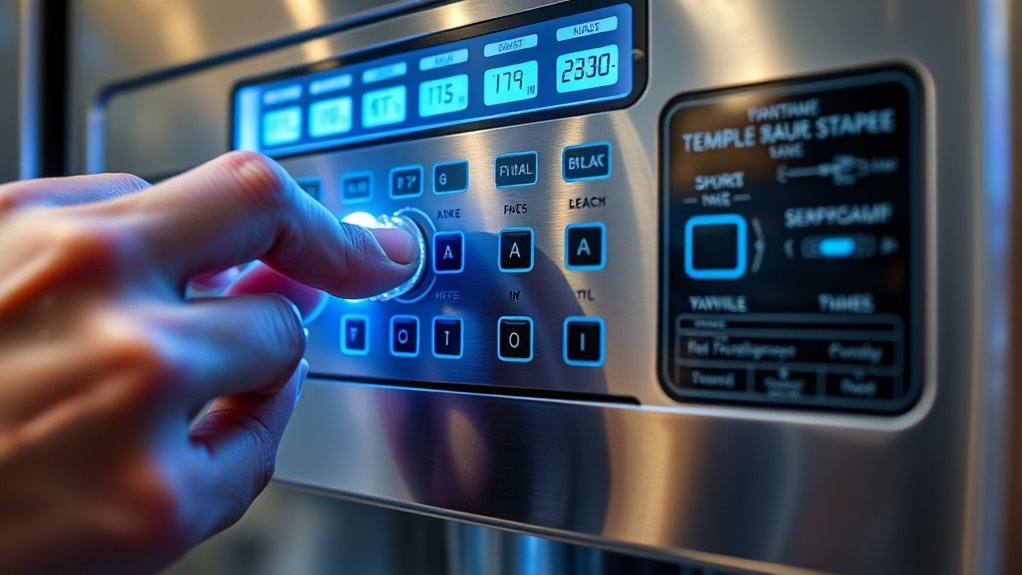
Setting your ice cream machine to the right temperature is essential for the best texture and taste. If the temperature is too high or too low, it can cause ice crystals or improper freezing. Knowing the ideal range helps you avoid these issues and guarantees consistent results. Proper refrigeration temperature settings are crucial for optimal performance and quality.
Optimal Temperature Range
Maintaining the correct refrigeration temperature is essential for ensuring your ice cream machine produces smooth, creamy ice cream consistently. The ideal temperature range is typically between -5°C and -10°C (23°F to 14°F). Staying within this range enhances flavor and helps preserve ingredient ratios, resulting in better texture and taste. If it’s too cold, ice crystals form, affecting smoothness; too warm, and ingredients may separate. To keep your machine at the right setting, consider these tips:
- Regularly check thermometer readings.
- Adjust the temperature based on ambient conditions.
- Avoid frequent door openings.
- Use consistent ingredient ratios for best flavor enhancement.
- Refrigeration technology can help monitor and optimize temperature controls more effectively.
Proper temperature control is key to perfect ice cream every time.
Effects of Improper Settings
When your refrigeration temperature drifts outside the recommended range, it can seriously impact the quality of your ice cream. Improper settings hinder flavor infusion and ingredient blending, leading to inconsistent texture and taste. If it’s too warm, ingredients won’t blend properly, causing separation and ice crystal formation. Too cold, and flavors become muted, risking overfreezing. Here’s how temperature affects your machine:
| Temperature Effect | Result |
|---|---|
| Too high | Poor ingredient blending, weak flavor infusion |
| Too low | Overfreezing, compromised texture, muted flavors |
| Slightly off | Uneven consistency, inconsistent quality |
| Perfect | Smooth blending, excellent flavor infusion, ideal texture |
Maintaining proper temperature ensures your ice cream’s quality and consistency.
Common Components and Their Functions in Ice Cream Machines
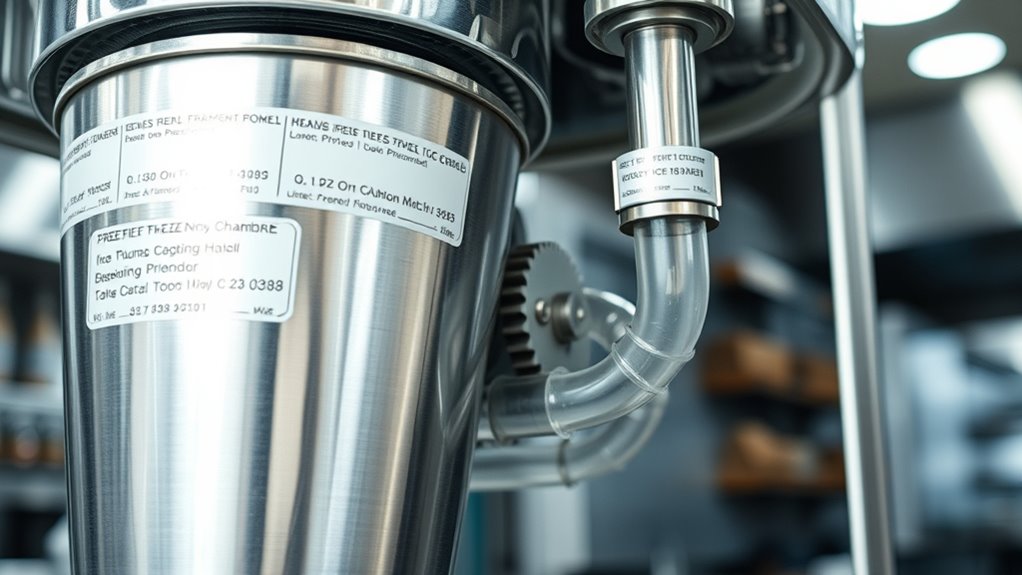
Ice cream machines are composed of several key components that work together to produce smooth, frozen desserts. These parts ensure proper flavor infusion and ingredient blending, creating the perfect texture and taste.
- Freezing Cylinder – Freezes the mixture while mixing, ensuring consistent temperature and smoothness.
- Agitator Paddle – Stirs ingredients continuously, aiding in proper blending and preventing ice crystal formation.
- Chill Tank – Maintains the cold environment needed for effective freezing and flavor infusion.
- Product Discharge Valve – Releases the finished ice cream, preserving the desired consistency.
Understanding these components helps you grasp how the machine functions to deliver delicious, evenly blended ice cream every time.
Signs of Proper vs. Improper Ice Cream Consistency
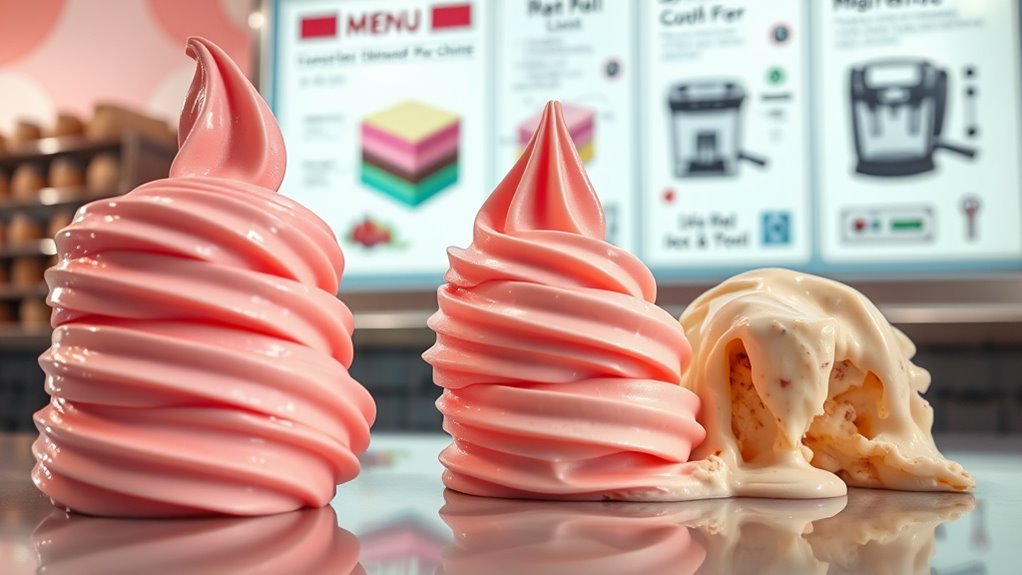
Proper ice cream consistency is noticeable through its texture and appearance; it should be smooth, creamy, and scoopable without being too hard or too soft. If you notice ice crystals forming or a grainy texture, sugar crystallization might be occurring, which indicates improper mixing or temperature control. Properly made ice cream will also showcase good flavor infusion, meaning flavors are evenly distributed without separation or muddiness. Improper consistency might feel overly icy or sticky, making it difficult to serve or enjoy. You want a uniform, velvety surface that melts smoothly on your tongue. These signs point to whether your machine is working correctly and your ingredients are well-balanced. Recognizing these cues helps ensure you produce high-quality ice cream every time.
Troubleshooting Tips for Common Machine Terminology Confusions
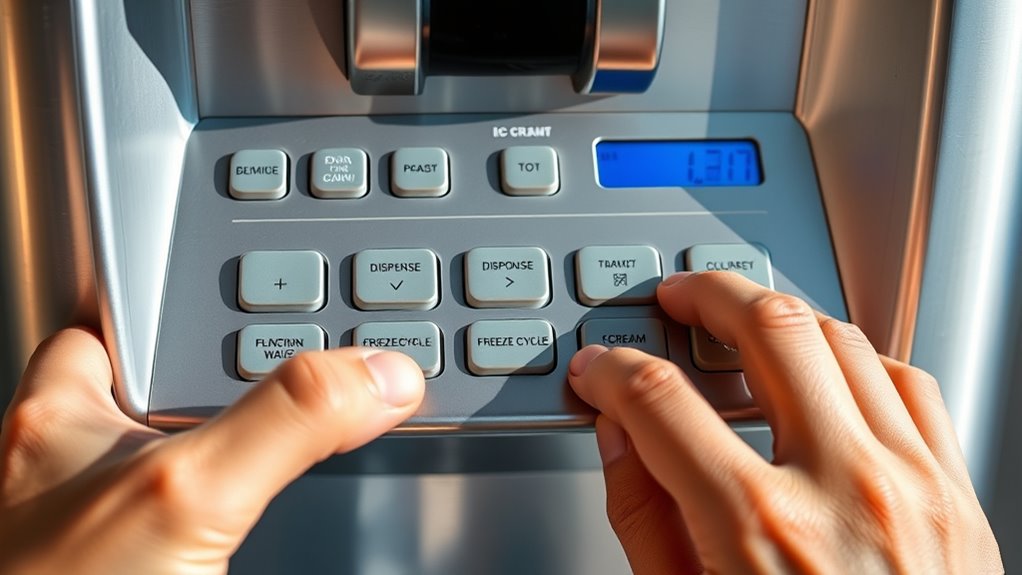
Understanding the common terminology used in ice cream machine operation can prevent confusion and improve troubleshooting. Misunderstandings about terms like flavor infusion and machine calibration often lead to unnecessary delays. To avoid this, keep these tips in mind:
Knowing key ice cream machine terms helps prevent confusion and speeds up troubleshooting.
- Know that flavor infusion refers to how ingredients are blended into the mix—improper infusion can cause uneven textures.
- Recognize that machine calibration ensures the proper temperature and speed, directly affecting consistency.
- Regularly check calibration settings to prevent over- or under-churning.
- When encountering issues, confirm that terminology aligns with your machine’s functions—clarity here speeds up problem-solving.
Mastering these terms helps you identify issues quickly, ensuring smooth operation and delicious results every time.
Frequently Asked Questions
How Does Ambient Temperature Affect Ice Cream Machine Performance?
Ambient temperature directly impacts your ice cream machine’s performance. When the temperature is too high, the machine struggles to maintain proper freezing, reducing efficiency and risking inconsistent textures. Conversely, cooler ambient temperatures help the machine operate smoothly, improving efficiency and ensuring your ice cream freezes evenly. You should monitor ambient temperature regularly and adjust your machine’s settings accordingly to keep performance ideal and achieve the best quality ice cream.
What Maintenance Is Required to Keep the Machine Running Smoothly?
You need to give your ice cream machine superhero-level maintenance! Follow cleaning protocols diligently to banish any buildup that could ruin your treat. Regularly check and stick to lubrication schedules to keep parts moving smoothly, preventing unexpected breakdowns. Neglecting these steps is like ignoring the engine in a race car—your machine will falter at the worst moment. Stay proactive, and your machine will serve perfect ice cream every time!
Can Different Ingredients Alter the Machine’S Terminology and Settings?
Different ingredient variations can definitely alter your ice cream machine’s terminology and settings. When you experiment with flavor customization using various ingredients, you might notice changes in mixing times or temperature adjustments to optimize texture. These ingredient differences influence how your machine operates, so always check your manual for specific settings related to new ingredients. Staying aware of these variations guarantees smooth operation and delicious, customized ice cream every time.
How Do I Choose the Right Machine for Specific Ice Cream Types?
When choosing the right ice cream machine, consider your desired flavor customization options and batch capacity. If you want to create unique flavors, look for machines with adjustable settings and multiple flavor options. For larger production needs, pick a machine with higher batch capacity to save time. This guarantees you get the right features for your specific ice cream types, making your process efficient and tailored to your preferences.
What Safety Precautions Should I Follow During Machine Operation?
You should prioritize machine safety by always following operational guidelines closely. Before starting, check for any damaged parts or leaks, and guarantee the area is clear of obstacles. Wear appropriate protective gear, like gloves and aprons, to prevent injuries. Never bypass safety features or rush the process, and turn off the machine before cleaning or maintenance. Staying vigilant and adhering to safety protocols helps prevent accidents and keeps your equipment running smoothly.
Conclusion
Now that you’ve uncovered the secrets behind ice cream machine terms, you’re closer to perfecting your craft. But here’s the twist—there’s always more to discover that could elevate your ice cream game even further. Are you ready to unveil those hidden insights and truly master every aspect of the process? The journey doesn’t end here. Keep exploring, experimenting, and pushing boundaries—you never know what delicious surprises await just around the corner.





